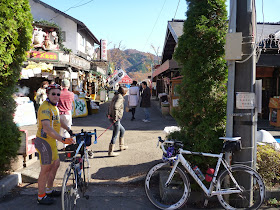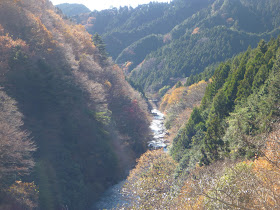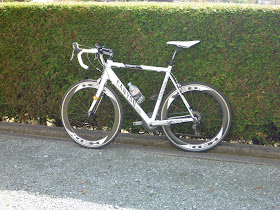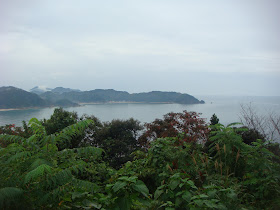After a night in the comfort of the Sakaeya Ryokan in Shokawa, in deep rural Northwest Gifu, I awoke feeling at least as if at least my cold had not gotten any worse, and I could start day two on the bike without holding Jerome back, or doing myself any damage.
It was apparent from walking around the inn, and from the offer that we leave our bikes inside the front door, blocking access, that we might be the only guests. In the morning, when she brought coffee to our room and we settled up the bill, we asked the innkeeper about the place.
So, it must be quiet now, before the ski season. Do you get many guests in the winter? She replied, "Hmmmm, well I guess there is a little ski area up the valley ... " [Translation: "No guests in winter"]. Well, how about in the summer then? "It is pretty quiet around here in the summer." [Translation: "No guests then either."] The inn was in good shape, the room we stayed in looked near new. Finally, she volunteered, "sometimes we get a group that will stay when they play at the golf course up the road." When was the inn built? "This building, in 1989, ... but we have been open since the Taisho era, and are now the 3rd generation. We used to get merchants stopping through on their travels, but ever since the expressway was built ... not many people come around here."
I guess most businesspeople take the expressway, instead of riding their bicycle to a business meeting 900 km from home ...
We left in the fog and climbed very gradually (1-2-3% grades) out of the valley less than 100 meters vertically and 8 km or so further onto a plain where we reached a small settlement - Hirugano Kogen/Takasu Cho. There was a Daily Yamazaki convenience store, complete with benches across the front exterior, the main one occupied by a very satisfied looking cat. The cat clearly belonged to the store, as its water and food bowls were under the bench (Jerome noted that the cat's porcelain bowl was made in France, and of a type he had once imported into Japan, in a previous job many years ago -- yet another small contribution he has made to the welfare of Japan). The sun came out as we ate breakfast. A younger man waiting for a shuttle bus to take him to his job at an onsen chatted us up. When I mentioned to the older man at the cash register how calm ("otonashii") the cat seemed, he seemed genuinely glad that I had noticed and assured me that there was a second cat around that was the opposite, always hiding from customers and sneaking around. As we mounted our bikes to ride off, two very energetic looking old ladies pulled into the parking lot in a mini-car and literally applauded and cheered when they saw two odd foreign cyclists, just heading out.

With that send-off, and the fog completely burned off, we saw that the fall colors were still vibrant, the air clear and clean, and we were on the beginnings of a very gradual 20 km descent, much of it along a river valley. All seemed right in the world.
 |
| Hida Highway, Route 156, in Takasu |
 |
| On the descent down Route 156 in Takasu |
On this stretch, I saw a pension (inn) with the name "White Pecker". At first, I could not imagine why a pension might have that name (?), then it struck me -- the bird in "shiro tori" (White Bird) must be a wood pecker, not the swan that uses the same characters but is pronounced "haku cho" instead.
Anyway, we reached Shirotori and turned to the west onto a 400m elev climb, first up a circular bridge -- the Japanese road equivalent of a spiral staircase -- and then found yet another entrance to a road tunneling through a mountain, closed to bicycles. Instead we headed up the old road, far under a different expressway. Again, it was a connector to the mid-air Tokai Hokuriku Expressway, closed to bicycles.
 |
| Yes, the dot way up ahead is Jerome, now in good climbing form. |
 |
| Now above the highway, looking back down at White Bird, Gifu |
 |
| Cresting Aburazaka Pass ... shorts and short sleeves in the mountains in November! |
Then we looped back and forth and eventually were above the same ribbon of road, reached Aburazaka Pass, and began almost 50 km of gradual downhill and flat, slowed only by a headwind as passed some long reservoirs and then descended the winding gorge of the Kuzuryu River. Neither of us knew what to expect here, and so it was a pleasant surprise that we found ourselves on a good road surface, without too much traffic, and on a cool sunny day even the reservoir was sparkling. We were very happy to emerge from the gorge into the flat area around Echizen Ohno, out of the mountains at last and ready for lunch of "rice omelet" and side dishes.
The next segment of our trip illustrates an important rule of cycling in Japan. Never assume just because a road is "National" instead of "Prefectural" that it will be a major route. And never assume the "Prefectural" one will not be. This seems especially to be the case in Fukui Prefecture. Fukui Prefecture seems to have more funds than the National government for road construction and repair. It is known as the "nuclear Ginza", the home to 13 nuclear power plants, the most concentrated in the world, and it looks very prosperous -- the biggest houses, largest birth weight babies, and most medical clinics per capita, also, according to an article in the
most recent Businessweek.
We left Echizen Ohno and headed onto National Route 476, which seemed like the most direct road, bearing south of Fukui City -- hypotenuse instead of legs of the triangle. Strangely, it had no traffic. After a few kilometers we passed a "road closed" sign warning we would need to stop in 1 kilometer. Then a climb started, into the woods and the road narrowed to a single lane -- more of a "rindo" (forest road) than a "kokudo" (national road). We came up to the road construction sight, and found this.

The hole was very deep, and there was no obvious way around on either side as far as one could see. The helper down in the trench was using a cord to pull himself up and out of the steep bank. The bulldozer operator took one good look at us, then a long puff of his cigarette, then said "you cannot make it on a bicycle; you will need to carry it". It was a remarkable statement of the obvious -- no, my bike cannot ride through a 5 meter deep, 10 meter across hole! Yet it was also incredibly bold and helpful -- no effort to turn us back. No worry about liability if we should slip and fall clambering into or out of the hole. In fact, the helper in the trench with the cord held my bicycle so that I could lift it first and then climb out with my hands free. After offering our thanks, we continued up National Route 476, again no traffic for the next 10+ kms, as we climbed a few hundred meters to a pass, along the ridge, then down the other side and into and through another beautiful, isolated farming valley.
 |
| Route 476 looking back at Echizen Ohno |
 |
| Kokudo, not Rindo (?) |
After 22 km on Route 476, we finally reached PREFECTURAL Route 2. This looked to offer our last climb before Echizen City, again a short cut in exchange for going over a hill. On my map, it looked to be 200-250 meters to the top. But after a short uphill at 2-3% grade, we saw a new tunnel mouth, and the pavement inside the tunnel was tipped
down away from us. Whoosh, we zoomed through the base of the mountain and came out on the plain just to the west of Echizen City, onto Route 8 -- a major road with heavy truck traffic, but at least a decent shoulder.
South of Echizen, Route 8 is unpleasant, but difficult to avoid. It heads Southwest over several small climbs and eventually reaches the Japan Seacoast offering a very nice view down the bay and across to the Tsuruga Peninsula, where the sun was already low in the sky.
 |
| Tsuruga Bay, Fukui |
 |
| Tsuruga Peninsula, Fukui -- there is a nuclear plant just this side of the tip of the peninsula, in the dark shadow, just about 10 km from the city center, while the accident prone "Monju" proto-type fast breeder reactor is just around the corner |
There were a few others at the rest area, snapping photos and admiring the view. And we met another long distance cyclist, traveling from Komatsu, Ishikawa Prefecture, toward Osaka. He was stretched out on a bench resting, just like we do sometimes. And he had extra lights for night riding, large water bottle, and plenty of clothes, just like we do.
His bike, on the other hand, was a mama-chari, and he was going at a slightly slower pace. And he was missing a good number of teeth, and did not say anything about business meetings on Monday.
At least it was reassuring to know that we are not the only long distance cyclists in Japan.
 |
| Time to head for the train station. |
I told Jerome that I had had enough, and planned to hop the train home from Tsuruga, another 20 km ahead. Two days and 410+ km was already too much, pushing my luck with the cold. And I would just hold him back if he wanted to press on far Friday night.
So we made good time through the traffic on Route 8 into the prosperous looking city, ate dinner at "Gusto" near the station, I gave Jerome a spare light, batteries and the complete set of photocopied maps, and we managed to attach his headlamp onto his helmet far enough back so it would not pull the helmet forward. Fed and restocked, he headed off another 50+ km to Maizuru, where he again found real sleeping accommodations Friday evening, to continue again on Saturday. I hopped the train back to Tokyo, and was in my house before 11PM.
Saturday I have been feeding him weather updates and mileage information. He was in heavy rain from midday to late afternoon when he reached Tottori, but the rain seems to have let up along the Japan Sea Coast as predicted, so he decided to continue on in the direction of Yonago by bicycle on Saturday evening. Any more detailed reports of Day 3 (or 4) will need to await his return.























































